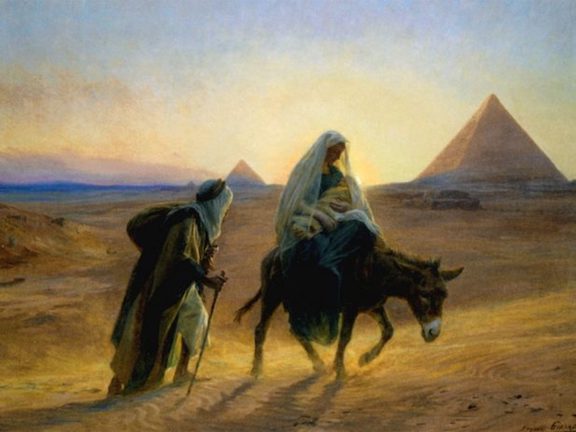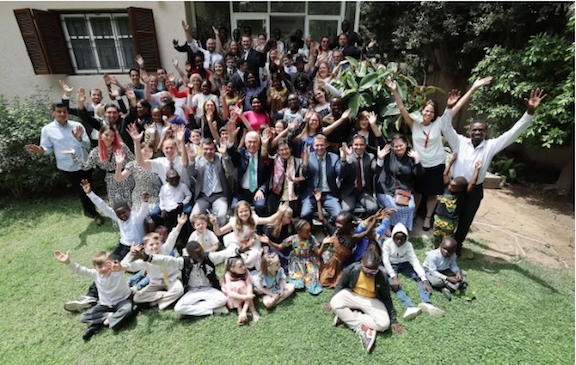Egypt
Egypt is significant to members of The Church of Jesus Christ of Latter-day Saints for several reasons.
Contents
History
The history of the people and cultures of the ancient Near East (which includes Egypt, Mesopotamia, Syria-Palestine, Anatolia, Greece, and Rome) spans centuries, includes empires and archaeological periods, fills countless volumes, and provides a bounty for scholars to study. For the purpose of this article, Egypt is briefly described as “a country in the northeastern corner of Africa. Much of Egypt is barren and desolate. Most of the inhabitants live in the Nile Valley, which stretches some 550 miles (890 kilometers)”[1] Millennia-old monuments sit along the fertile Nile River Valley, including Giza’s colossal Pyramids and Great Sphinx and Luxor’s hieroglyph-lined Karnak Temple and Valley of the Kings tombs.
Bible Stories of Interest to Latter-day Saints
Members of the Church of Jesus Christ believe in and regularly study the Bible. Within the text are the stories of Abraham, Joseph, Moses, and Jesus—all of whom lived part of their lives in Egypt—starting with Abraham living for a time in Egypt; the children of Israel, from the time Joseph was sold into Egypt to becoming a ruler and bringing his father Israel’s 12-son family to survive a regional famine; Moses being raised by pharoah’s daughter to abdicating his royal role to become a prophet leading the children of Israel and the miracles and momentous events that occurred throughout their 40-year trek through the wilderness to a promised land; and the young family of Joseph, Mary, and Jesus fleeing to Egypt to avoid King Herod’s decree to slay all young boys.
Abraham
Abraham left Canaan and traveled south to Egypt due to famine, where he lived for a short time before returning to the land of Canaan.
Facsimile 3 in the book of Abraham in the Pearl of Great Price shows that Abraham was invited by pharaoh to sit on the throne and teach principles of astronomy. The Lord blessed Abraham and Sarai spiritually, socially, and economically during their time in Egypt.[2]
Joseph
Due to another famine in Canaan, the sons of Jacob went to Egypt for food—where they encountered their brother Joseph, whom they had sold into slavery. Joseph had risen in importance in the house of pharaoh, enabling him to feed his father, brothers, and their families and to bring them to Egypt. Their move to Egypt eventually resulted in the Israelites’ enslavement in Egypt.
Moses
The story of Moses in Egypt is found in the book of Exodus. Although born to Hebrew parents, Moses was set afloat in a reed basket on the Nile river to spare him from the edict calling for the death of all Hebrew newborn males. He was found by pharaoh’s daughter and reared as a prince of Egypt. He was later called to lead the enslaved Israelites to freedom.
Jesus
At the time of the Savior’s birth, the ruler in Judea was known as Herod the Great. When this wicked man met with the wise men who had traveled to see Jesus, he asked them to return and inform him of what they discovered about the Christ child (see Matthew 2:8). Because of Herod’s wickedness, God warned the wise men not return to Herod. An angel appeared to Joseph in a dream and told him to take his family to Egypt. Joseph, Mary, and Jesus remained in Egypt until after the death of Herod the Great.[3]
Egypt in Latter-day Saint Scripture
Moroni writes to readers of the Book of Mormon that the record was written in “the characters which are called among us the reformed Egyptian,” meaning “altered, modified, or changed” [4] “according to [the Nephites’] manner of speech.”[5]
In the book of Mosiah readers learn that Lehi was "taught in the language of the Egyptians" therefore he could read the engravings on the plates of brass Nephi obtained from Laban.[6]
The book of Abraham in the Pearl of Great Price was translated from Egyptian papyri that came into the hands of Joseph Smith and which he translated beginning in 1835. An entrepreneur named Michael Chandler arrived at Church headquarters in Kirtland, Ohio, with four mummies and multiple scrolls of papyrus during a time when the Western world became interested in the antiquities unearthed in the catacombs of Egypt.
- By the time the collection arrived in Kirtland, all but four mummies and several papyrus scrolls had already been sold. A group of Latter-day Saints in Kirtland purchased the remaining artifacts for the Church. After Joseph Smith examined the papyri and commenced “the translation of some of the characters or hieroglyphics,” his history recounts, “much to our joy [we] found that one of the rolls contained the writings of Abraham.”[7]
This book of Abraham, a record of the biblical prophet and patriarch Abraham, recounts how Abraham sought the blessings of the priesthood, rejected the idolatry of his father, covenanted with Jehovah, married Sarai, moved to Canaan and Egypt, and received knowledge about the Creation. The book of Abraham largely follows the biblical narrative but adds important information regarding Abraham’s life and teachings.[8]
Christianity in Egypt
Christianity is the second largest religion in Egypt, according to Wikipedia. The history of Egyptian Christianity dates to the Roman era as Alexandria was an early center of Christianity.
Other than the Coptic Orthodox Church, two other Oriental Orthodox churches have members in Egypt: the Armenian Apostolic and Syriac Orthodox churches. A minority of Egyptian Christians belong to the Coptic Catholic Church.
“The persecution of Copts and the discrimination against Coptic Orthodox Christians are historic and widespread issues in Egypt. They are also prominent examples of the poor status of Christians in the Middle East despite the fact that the religion is native to the Middle East, and its practices are old in the country.”[9]
Elder Uchtdorf Ministers in Egypt
Elder Dieter F. Uchtdorf of the Quorum of the Twelve Apostles ministered in Egypt as part of a three-country Church assignment in April 2023. During their four days in Cairo, Elder Uchtdorf and his wife, Harriet, met in a combined sacrament meeting with the local English- and Arabic-speaking Latter-day Saints who comprise the two local branches.
Latter-day Saints in Egypt
“The Cairo Branch is the Church’s longest continually operating unit in the Middle East . . . . Some area branches may have been created earlier but also had some interruptions at some point.
“The branch was organized in 1974, when two students who arrived in Cairo for intensive study of Arabic, Dilworth B. Parkinson and John Sharp, got together with Carol Azeltine, a teacher at an international school in suburban Digla, and began holding Latter-day Saint services in the garden area of the American university in downtown Cairo. Later, individuals and families moved to teach, to work for oil companies and such, meeting in each other’s apartments in Maadi and then, beginning in 1981, in a leased villa.[10]
The branch today is composed mostly of Latter-day Saint individuals and families who have come to Cairo because of employment in the international diplomatic community or in the educational systems supporting those families.[11]
The Nile River Branch membership “includes Latter-day Saints who are refugees from South Sudan and other Arabic-speaking areas, as well as Egyptian Christian converts.”
“The current two-story, air-conditioned villa in Maadi has been used since late 1992. Latter-day Saint meetings in Cairo are held on Fridays, considered by Muslims to be the national holy day of the week, just like shabbat — the Jewish day of rest — is observed in Israel.”[12]
The Cairo Egypt District spans all of North Africa, from Morocco across to Egypt and down to Sudan and includes a branch each in Morocco and Tunisia and the two Cairo branches.[13]
The Church of Jesus Christ of Latter-day Saints, however, does not proselytize in Egypt.


